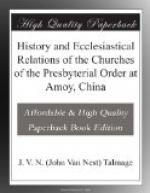The Committee next proceed to the statement of “certain historic facts.” As with the “admitted principles,” so with the “historic facts.” With some of them we have no dispute. But when they come to describe the present condition and relations of the churches at Amoy, their language, to say the least, is very unfortunate. “These six Churches,” say they, “have grown up together under such an interchange and community of labor on the part of our own Missionaries, and on the part of those belonging to the English Presbyterian Church, that all are said to have a two-fold ecclesiastical relation—one with England—one with America, and still a third, and economical and domestic relation among themselves, which is covered and controlled by what is styled ’The Great Presbyterial or Classical Council of Amoy.’”
We do not know by whom these native Churches “are said” to have a two-fold or three-fold ecclesiastical relation. It is not so said by the Missionaries. They contend that the native churches are neither English, nor American, but Chinese churches. They are ecclesiastically related to each other, and ought to remain so. But the effort is now made to sever this ecclesiastical relation to each other, and bring half of them into ecclesiastical relationship with the Church in America, making them the Protestant Reformed Dutch Church of North America, in China! At present the native churches have an intimate, but not an ecclesiastical, relation to both the Church in England and America.
From the above mistaken statement the Committee have drawn out three “particulars” which they seem to think especially worthy of note.
“1st. That while this Chinese Presbyterial or Classical Council is itself an autonomy—having the right to ordain ministers, exercise discipline, and do whatever else a ‘self-regulating Classis’ or Presbytery can or may do, still the whole in England is claimed to be the Presbytery of Amoy, and to this Synod it is reported as the Classis of Amoy.”




